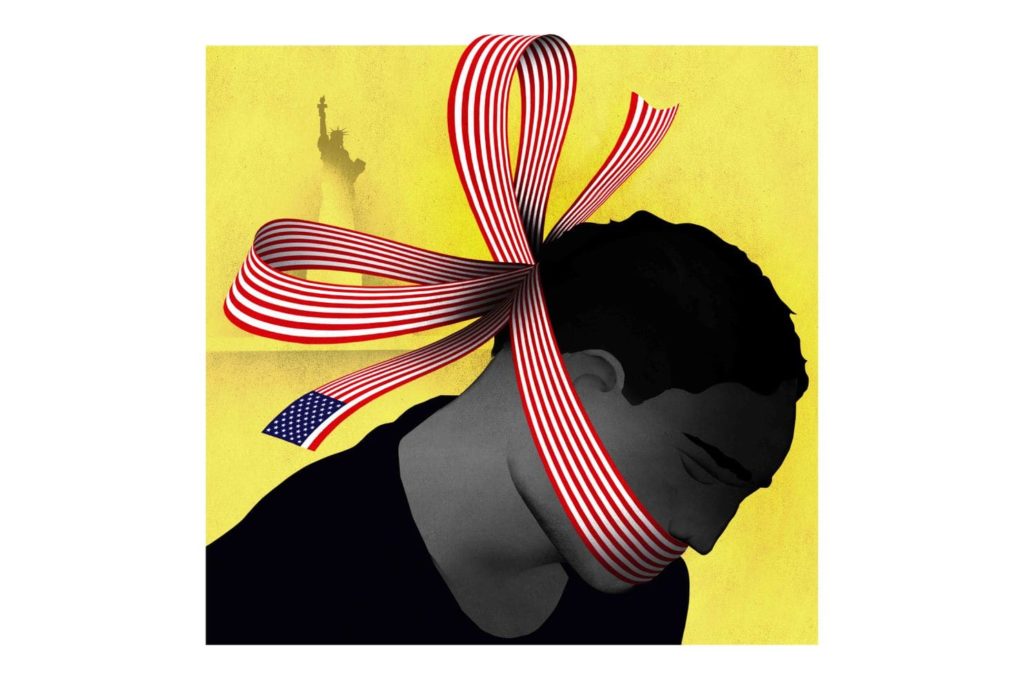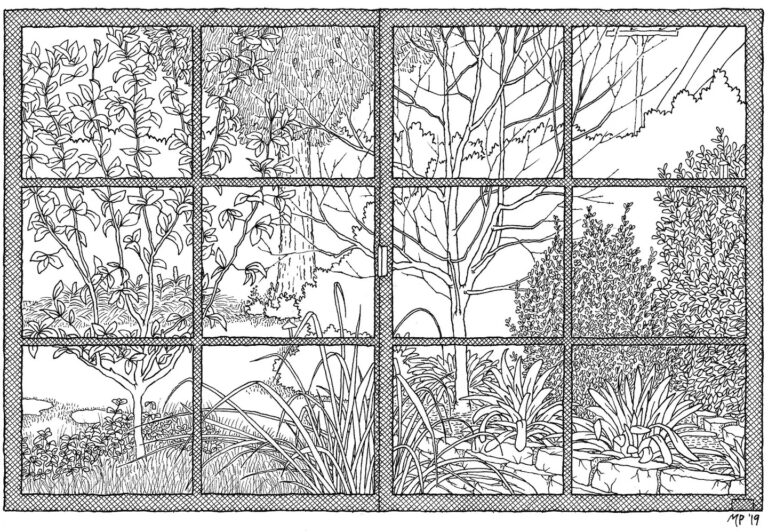Viet Thanh Nguyen discusses the meaning and effects of Trump’s recent comments about immigrants in this op-ed for The Washington Post.

When Donald Trump first proclaimed “Make America Great Again,” many white Americans focused on the slogan’s explicit appeal. Why wouldn’t we want America to be great again? But many of us who do not happen to be white understood the slogan’s subtext: Make America White Again. Immigrants, refugees and people of color have always recognized Trumpism for what it is — a politics of nostalgia for an era of unquestioned white superiority and power. Trump’s comments last weekend, that four congresswomen should “go back” to their ancestors’ countries if they don’t like this one, were also an argument that immigrants of color should simply be grateful to be here. Increasingly, post-white Americans are refusing to perform what many white Americans expect of them: docile compliance, with the implicit sequel of servitude. Instead, these proud Americans, who don’t hesitate to call Trump out, are both thankful and critical.
Call this mixture of gratitude and attitude a nuanced patriotism, a complicated love. Nuance like this is not a part of Trump’s rhetoric or his vision of America. Now, confronted by women of color who are not performing the gratitude and servitude he expects, he has made his own best case for even the most hesitant white people to recognize how white supremacy underlies his vision: “If they don’t like it here, they can leave.” This paraphrase of the classic insult “love it or leave it” implies that the four members of Congress do not belong to the United States, even though three of them — Alexandria Ocasio-Cortez of New York, Rashida Tlaib of Michigan and Ayanna Pressley of Massachusetts — were born here. (The fourth, Ilhan Omar of Minnesota, came here from Somalia as a girl and became a citizen.)
With these and other statements and silences, Trump is making whiteness, which has functioned as the politely invisible norm in American society, into the impolite, visible norm. Along the way, he is creating a situation where white people must choose: Be critical of their own whiteness or embrace it wholeheartedly. The fact that so many white people immediately recognized his racism is one good thing that has come out of this controversy, proof that they can identify and resist white supremacy.
Still, Trump’s appeal to a core group of Americans speaks to an uncomfortable truth in American history, which is that this is a country founded on the white racism of colonization, genocide, slavery and immigrant exploitation, which many white people who are not white supremacists benefit from. While Trump and his supporters would probably refuse words like “genocide,” they would still see the conquest of America by white people as a fact to be celebrated rather than apologized for. Trump’s vision of America is so explicitly racist that the 1950s can no longer be cited as the time period for which he might be nostalgic. The 1950s were the beginning of the end for government-sanctioned segregation and racist immigration laws that had kept out almost all nonwhite immigrants since the 1924 Immigration Act. What Trump wants is the America of the late 19th century, when Congress passed the 1882 Chinese Exclusion Act, the first time it targeted a racial group for immigration exclusion.
Asian immigrants, and their American descendants, can testify to the pain of perpetually being suspected as foreigners. “Where are you from?” was the not-so-friendly question that many us have experienced. And if we tried to say that we’re from here, we braced ourselves for the follow-up: “No, where are you really from?” How often is a white person subject to this question? Do people ponder Robert Mueller’s ancestry? No.
Because whiteness is a paradoxical amalgamation of essence and transformation. On the one hand, white people’s whiteness is natural, inevitable, normal. Until recently, most white people never had their whiteness challenged or thought twice about it. Now their whiteness is more often questioned, thrown into relief against “terrifying hordes” of brown people at the southern border and increasingly vocal and visible populations of color within the United States. Now white people have to confront their whiteness. Some understand that it entails white privilege and that if we are to have a more just society, some of that privilege must be given up. Others deny that white privilege exists and retreat even further into a defensive whiteness, which results, in its extreme, in white supremacy.
On the other hand, whiteness is mutable, changing and becoming more inclusive. During the period of Chinese exclusion, for example, the Irish were not white like the dominant Anglo-Saxon Protestants. The Irish and other Europeans of questionable desirability — Greeks, Italians, Polish, Catholics, Jews and so on — only gradually became white, beginning at the turn of the 20th century. A new, pan-European whiteness solidified as the country kept out those clearly not white. White middle-class and working-class identity formed, attached to varying degrees of economic prosperity, culminating in the election of the Irish descendant John F. Kennedy. This is the white privilege that results from getting into this country, getting jobs and other benefits that nonwhite people and women could not get, and claiming a forgetful Americanness, amnesiac about its origins.
A fusion of white supremacy and promised economic ascendancy is what Trump believes will repair the “American carnage” he identified in his inauguration speech. Here is another contradiction from a man of contradictions. He accuses these Democratic congresswomen of coming from places that are “a complete and total catastrophe . . . totally broken and crime infested,” but these are the same characteristics of a stricken America that he promised to fix. To think that they must “Make America Great Again,” he and his followers have to believe that America is like these other places, because it has been contaminated by the otherness brought in by nonwhite people. Against this terrifying mixing, he and his supporters want a comforting ideological, moral and racial purity.
That is what is most dangerous about Trump: the nostalgia for purity that supposes America is a white homeland and that motivates him and his followers to tell others to go back to faraway homes. This nostalgia is based on a fiction that the uncontaminated America is an immaculate place, despite the realities of an imperfect social fabric and the many tragedies taking place in actual American households: divorce, violence, homophobia, mental illness, unemployment and drug abuse — to name only some maladies. As for many immigrants, their new home in America is often as much a place of discomfort, even torment, as one of love and belonging. Immigrant stories are full of pain — the trauma of past wars and refugee experiences, the brutality of working constantly, the mundane destruction of affection that comes about when parents cannot spend time with increasingly distant children.
Not surprisingly, home has been a preoccupation for many American storytellers besides Trump. Against the Trumpian story of a Great White Nation, many of our storytellers have been telling more complex tales about America since at least the time of the runaway slave Frederick Douglass, whose home had been a plantation. It was no mistake that Toni Morrison, in “Beloved,” named the slave plantation in her novel Sweet Home. It was also no accident that Luis Alberto Urrea called his Great (Mexican) American Novel about a loving yet dysfunctional family — set on the border between California and Mexico — “The House of Broken Angels.” For many Native Americans, home was a reservation, a U.S. government euphemism for open-air ghettoization, and the setting of memorable novels by Sherman Alexie, Louise Erdrich and Leslie Marmon Silko. For Asian Americans, claustrophobic homes where immigrants hid are endless, as in Maxine Hong Kingston’s “The Woman Warrior,” Amy Tan’s “The Joy Luck Club” and countless other books. Celeste Ng took this problematic home to its logical conclusion in “Little Fires Everywhere,” when the rebellious daughter of a white Ohio family runs away after burning down the family’s seemingly perfect suburban house. This is what whiteness has always been about in America: the great illusion that covers the enduring alienation, the spiritual loss that underlies the American Dream and gives it dramatic tension, as Jack Kerouac showed in “On the Road.” Even Trump, with his notion of “American carnage,” can be understood as an inheritor of Kerouac. What our storytellers have told us, over and over, is that home is often a complicated place that some want to stay in and some cannot wait to leave. Love it or leave it? If only life were so simple!
Nostalgia, which means homesickness, eradicates this complexity. Home often appears in our memory through a distorting longing so strong it borders on illness, where we forget all that might have been wrong and fetishize all that seemed good. “Make America Great Again” is an expression of this homesickness, threatening to hurt us all by defining home in only one way and turning it into propaganda, in the process expelling all those who do not fit home’s definition. Those fearful of change are homesick for an America that was, in fact, not so great for many people, including those white people who never benefited from America’s promise, from the poor to the working class to women of many backgrounds. To truly make America great requires the paradoxical ability to see that America as a home has always been imperfect. To make America a home for everyone means acknowledging that home is what we love and fear, what we remake and renovate.
This is not a hopeless project. In the late 19th century, almost no one helped Chinese immigrants. They had to defend themselves. Today, the spectacular cruelty of Trump’s rhetoric and his immigration policies is attacked constantly, both by people of color and by white people of conscience. We are a different America now (although that does not mean we cannot regress). To progress, we must redefine home and who belongs to it. While Trump wants to separate us into white Americans and everyone else, we must forge connections among people who do not look or think alike. We must say that this home is capacious enough for the white people to whom Trump appeals and for the rest of us, and that our destinies are tied together in a fateful kinship that no amount of border-closing or deportation will forestall. Economic prosperity does not have to be tied to nostalgic white supremacy. Instead, economic equality can emerge only by working through the agonies of our racial history, one that has exploited the poor of all colors and divided struggling white people from their nonwhite allies who also seek economic justice.
This is our American home. Passions are high, voices are loud, but this is the reality: Home is where we are, home is what we claim, and no one can tell us to go home if we are already at home.


